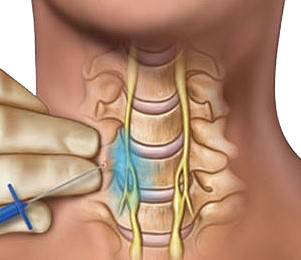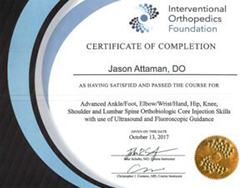Your injury may have happened in a flash, but the pain has compounded and has made daily life much worse. Perhaps the accident or incident keeps playing back in your head and you’re anxious all the time, or you’ve become petrified of driving or other activities, or you panic and snap at other people in an uncharacteristic way. Even if you’ve physically recovered, secondary injuries or conditions may always remind you of the hard fist of misfortune, and may trigger PTSD.
The most common traumatic injury is a car accident, but motorcycle accidents, machinery accidents, workplace injuries, assaults, muggings, robberies, miscarriages, animal attacks, and other traumas can cause PTSD. You haven’t felt like yourself for a while, you miss your pre-trauma daily life, and the PTSD reactions have gotten in the way of your healing and picking up where you left off.
Stellate ganglion block (SGB) is a completely medical procedure that can help break the vicious cycle by calming your reactions to PTSD triggers. If you’re a victim of a traumatic injury, it’s very likely you’ve seen a psychologist or psychiatrist, and that that mode of therapy has helped to one degree. SGB is complementary to therapy, in that it can work in tandem with a therapist’s efforts, or can pick up where they left off.
The stellate ganglion is a bundle of nerves that is located deep in the lower neck. It is located within the cervical sympathetic chain. Sympathetic nerves play a strong role in our fight-or-flight response. When you have PTSD, these nerves malfunction and are constantly sending distress signals to your brain and body. Injecting local anesthetic (numbing medicine) around these nerves is called a stellate ganglion block (SGB). SGB resets these nerves that are chronically in fight-or-flight response. This is similar to rebooting your computer; after the “SGB reboot,” your nerves function normally. Stellate ganglion block (SGB) injections need to be performed under either ultrasound and/or fluoroscopic guidance as there are major blood vessels and organs nearby. The SGB injection is not new and has been used for 100 years to treat painful conditions such as chronic regional pain syndrome (CRPS) of the upper extremity. More recently, SGB is being used to treat PTSD.
Contrary to popular belief, stellate ganglion block is not only a PTSD treatment option for veterans and law-enforcement officers. It’s effective for a wide range of PTSD sufferers, including victims of car accidents and other traumatic injuries.
I (Dr. Jason Attaman) have helped people in all kinds of situations overcome their PTSD. I have performed SGB procedures since 2007 for various conditions including PTSD. Besides my medical experience, I am in a unique position to help because I understand a few things that may be true of your situation:
- You feel you’ve exhausted your options, between therapy, antidepressants or other medications, and advice from others. Those may have helped, but you’re not out of the woods yet, and your time and patience are stretched thin.
- Simply “taking it easy” or avoiding certain activities in daily life isn’t the solution, or the entire solution. Especially if you’ve physically recovered from your accident, you already feel you need to make up for lost time, and don’t want to drag the recovery out to the point that it’s not really a recovery.
- You worry the treatment may be painful, and you are concerned that you might not be in control.
In my care, you’re always in control, and what you are comfortable with is exactly what we’ll do. With stellate ganglion block I have helped many traumatic-injury victims calm their nerves, move past PTSD, and regain control of their lives. It is fulfilling for me and doubly so for my patients. You can contact my office in Bellevue, WA to discuss your needs and to schedule an appointment.
Learn More about Stellate Ganglion Block for PTSD
Our office is in Bellevue, WA, but we have helped PTSD sufferers from all over the US and Canada (with many Canadian patients coming from British Columbia). I may be able to help you, too. The clinic is easily accessible from British Columbia and Alberta and we offer a telemedicine consultation to verify that you are a good candidate for these injections. Patients can stay overnight in Bellevue, Washington, and have the treatment completed over 2 days.
We offer a substantial discount to US Military veterans, active-duty personnel, and law enforcement. (Many of our patients come from nearby Joint Base Lewis-McChord.)
What is a Stellate Ganglion Block (SGB)?
The stellate ganglion is a bundle of nerves that is located deep in the lower neck. It is located within the cervical sympathetic chain. Sympathetic nerves play a strong role in our fight-or-flight response. When you have PTSD, these nerves malfunction and are constantly sending distress signals to your brain and body. Injecting local anesthetic (numbing medicine) around these nerves is called a stellate ganglion block (SGB). SGB resets these nerves that are chronically in fight-or-flight response. This is similar to rebooting your computer; after the “SGB reboot,” your nerves function normally. Stellate ganglion block (SGB) injections need to be performed under either ultrasound and/or fluoroscopic guidance as there are major blood vessels and organs nearby. The SGB injection is not new and has been used for 100 years to treat painful conditions such as chronic regional pain syndrome (CRPS) of the upper extremity. More recently, SGB is being used to treat PTSD.
The only physicians that are formally trained in the SGB procedure are Interventional Pain Management physicians (MDs and DOs). We learn how to safely perform SGB during a year-long advanced training program called a Pain Medicine fellowship. A fellowship is the highest level of training a physician can complete and is done after four years of medical school, one year of internship, and three years of residency. Even then, the SGB technique used for PTSD treatment is more complex than when used for painful conditions and in many cases requires even more refinement after fellowship. For example, SGB used for PTSD treatment is done under ultrasound at two different levels and great care is taken to ensure a proper Horner’s syndrome after the SGB procedure. This is rarely the case in a standard SGB procedure when used for pain. Stellate ganglion block is a technically demanding procedure that requires precise image guidance using an ultrasound machine and sometimes a form of x-ray called a fluoroscope. We always prefer to use ultrasound as it allows us to better visualize nerves, arteries and veins in this delicate area.
You may wonder why some physicians use ultrasound while others use fluoroscopy. The answer is fairly simple; it is much safer and accurate to use ultrasound but much more difficult to learn this method. Fluoroscopy is faster but does not allow for the visualization of delicate nerves and blood vessels in the area. The procedure is non painful, as it involves only a single needle poke in the side of the neck after numbing the skin. Typically, we will first perform SGB on the right side of your neck, as medical studies have found the right side to be most efficacious in most people. However, less than 5% of patients may require an SGB on the left side of the neck if they do not respond to a properly performed right sided SGB procedure. If you are visiting us from far away, we will typically schedule a right SGB followed by a left SGB on a subsequent day to ensure that you have the best opportunity for optimal outcomes. For safety reasons, we do not treat both sides on the same day. In our clinic, we have top of the line ultrasound machines and flouroscopy available. With rare exception, we prefer to perform this procedure under ultrasound guidance.

